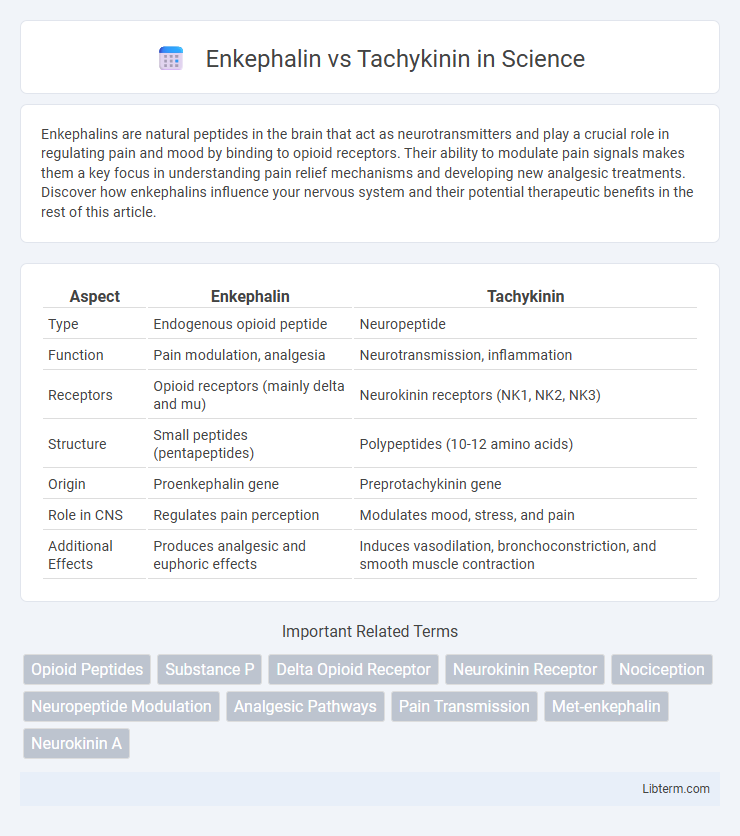Enkephalins are natural peptides in the brain that act as neurotransmitters and play a crucial role in regulating pain and mood by binding to opioid receptors. Their ability to modulate pain signals makes them a key focus in understanding pain relief mechanisms and developing new analgesic treatments. Discover how enkephalins influence your nervous system and their potential therapeutic benefits in the rest of this article.
Table of Comparison
| Aspect | Enkephalin | Tachykinin |
|---|---|---|
| Type | Endogenous opioid peptide | Neuropeptide |
| Function | Pain modulation, analgesia | Neurotransmission, inflammation |
| Receptors | Opioid receptors (mainly delta and mu) | Neurokinin receptors (NK1, NK2, NK3) |
| Structure | Small peptides (pentapeptides) | Polypeptides (10-12 amino acids) |
| Origin | Proenkephalin gene | Preprotachykinin gene |
| Role in CNS | Regulates pain perception | Modulates mood, stress, and pain |
| Additional Effects | Produces analgesic and euphoric effects | Induces vasodilation, bronchoconstriction, and smooth muscle contraction |
Introduction to Enkephalin and Tachykinin
Enkephalins are endogenous opioid peptides that modulate pain by binding to opioid receptors in the central nervous system, primarily influencing analgesia and stress response. Tachykinins, a family of neuropeptides including substance P, regulate diverse physiological processes such as neurotransmission, inflammation, and vasodilation by activating neurokinin receptors. Understanding the distinct receptor interactions and functional roles of enkephalins and tachykinins is crucial for developing targeted therapies for pain management and inflammatory conditions.
Overview: Peptide Neurotransmitters
Enkephalins and tachykinins are peptide neurotransmitters that play critical roles in modulating pain and inflammatory responses within the nervous system. Enkephalins primarily act as endogenous opioids, binding to opioid receptors to inhibit pain signals and produce analgesic effects. Tachykinins, including substance P, function by activating neurokinin receptors to promote neurotransmission related to pain, inflammation, and smooth muscle contraction.
Chemical Structure Comparison
Enkephalins and tachykinins are neuropeptides with distinct chemical structures that determine their biological functions; enkephalins are pentapeptides primarily composed of the sequence Tyr-Gly-Gly-Phe-Met or Leu, acting as endogenous opioid ligands. Tachykinins, such as substance P, are longer peptides characterized by a conserved carboxyl terminal sequence, typically FXGLMamide, which interacts with neurokinin receptors. The primary structural difference lies in enkephalins' shorter, opioid-mimetic chain versus tachykinins' extended, receptor-specific peptide sequences critical for neurotransmission and pain modulation.
Biosynthesis and Metabolism
Enkephalins are pentapeptides synthesized from the precursor protein proenkephalin through enzymatic cleavage primarily by prohormone convertases in neurons, whereas tachykinins like substance P are derived from the preprotachykinin gene via specialized post-translational processing. Enkephalins undergo rapid metabolism by enkephalinases such as aminopeptidase N and neutral endopeptidase, leading to their short half-life in synaptic clefts, while tachykinins are degraded mainly by peptidases including endopeptidase 24.11 and angiotensin-converting enzyme, modulating their signaling duration. The distinct biosynthetic pathways and metabolic enzymes of enkephalins and tachykinins influence their physiological roles in pain modulation and neurotransmission.
Receptor Types and Binding Mechanisms
Enkephalins primarily bind to opioid receptors, specifically the delta and mu receptor types, utilizing G-protein-coupled receptor mechanisms to modulate pain and reward pathways. Tachykinins interact mainly with neurokinin receptors NK1, NK2, and NK3, which are also G-protein-coupled but activate distinct intracellular signaling cascades involved in inflammation and neurotransmission. The binding affinity and receptor subtype specificity of enkephalins and tachykinins determine their functional roles in the nervous system and influence therapeutic targeting strategies.
Roles in Pain Modulation
Enkephalins act as endogenous opioid peptides that inhibit pain transmission by binding to opioid receptors in the central nervous system, producing analgesic effects. Tachykinins, including substance P, facilitate pain signaling by activating neurokinin receptors, which enhance the perception of pain and inflammation. The balance between enkephalin-mediated inhibition and tachykinin-driven excitation is crucial for regulating pain sensitivity and developing targeted analgesic therapies.
Functional Differences in the Nervous System
Enkephalins primarily function as opioid peptides that modulate pain perception by binding to opioid receptors, resulting in analgesic effects and the inhibition of neurotransmitter release. Tachykinins act as neuropeptides that facilitate excitatory neurotransmission and promote inflammation through binding to neurokinin receptors, influencing processes like pain transmission and smooth muscle contraction. The distinct receptor interactions of enkephalins and tachykinins underline their opposing roles in neural signaling, with enkephalins generally suppressing and tachykinins enhancing neural activity in the nervous system.
Clinical Implications and Therapeutic Uses
Enkephalins, endogenous opioid peptides, play a critical role in pain modulation and are targeted in developing opioid analgesics with fewer side effects compared to traditional opioids. Tachykinins, including substance P, are involved in neurogenic inflammation and pain transmission, making NK1 receptor antagonists valuable in treating conditions like chemotherapy-induced nausea and chronic pain syndromes. Therapeutic strategies focusing on enkephalins aim to enhance analgesia and reduce opioid dependency, while tachykinin receptor modulation offers potential for novel anti-inflammatory and antiemetic therapies.
Enkephalin and Tachykinin in Disease States
Enkephalins, endogenous opioid peptides, modulate pain perception and exhibit neuroprotective effects in conditions such as chronic pain, addiction, and neurodegenerative diseases. Tachykinins, including substance P, are involved in inflammatory responses and are linked to asthma, migraine, and neuroinflammatory disorders. Imbalances in enkephalin and tachykinin signaling pathways contribute to pathophysiological mechanisms underlying these disease states, making them targets for therapeutic intervention.
Future Research Directions
Future research on enkephalins and tachykinins should investigate their distinct roles in neuroinflammation and pain modulation pathways using advanced molecular imaging and gene editing techniques. Exploring receptor subtype-specific agonists or antagonists could lead to targeted therapies for chronic pain and neurodegenerative disorders. Integration of multi-omics data will enhance understanding of their interactions within neuropeptide networks and facilitate personalized medicine approaches.
Enkephalin Infographic

 libterm.com
libterm.com